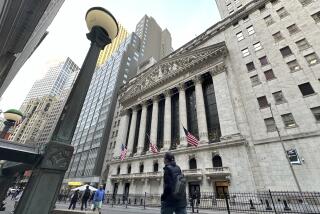Though cheered by Wall Street, most mergers don’t work out for buyers
— Wall Street’s big business — helping companies buy other companies — is hotter than it’s been in years.
When pharmaceuticals giant Actavis said it was buying Allergan Inc. in Irvine and Halliburton said it would take over rival oil-field servicer Baker Hughes, Wall Street rang up a rare $100-billion deal day that pushed the total value of mergers globally to more than $3.2 trillion for the year, according to banking research firm Dealogic.
The two merger agreements Nov. 17 arrived amid cheers from Wall Street analysts and triumphal statements by executives.
“This acquisition creates the fastest-growing and most dynamic growth pharmaceutical company in global healthcare,” said Actavis Chief Executive Brent Saunders.
Lost in the hubbub: a raft of studies showing that over time, most of the deals will not work out. The buyer, the apparent winner in the deal, will be worse off than before.
“It’s a big risk. You’re willing to pay more for a company than anybody else in the world thought it was worth,” said Mark L. Sirower, author, lecturer and principal at Deloitte Consulting in New York. “You’ve got to do your homework.”
Sirower, a specialist in mergers and acquisitions, is among a number of scholars to compile evidence over several decades showing that, on average, the buyer ends up performing worse financially than its rivals over time.
One study of 302 significant deals, for instance, found that “on average, acquirers underperformed their industry peers in providing returns to shareholders.” Earlier studies showed that as many as 60% of all deals turned out poorly for the buyer, with the damage ranging from the marginal to the disastrous.
The data seem counterintuitive, given the hoopla that surrounds most deals. The initial publicity invariably is dominated by the combining firms themselves and their Wall Street matchmakers, which have had plenty of time to polish their sales jobs while deals are being secretly negotiated.
It’s only later that historic flops crop up. Lists of famous mistakes usually start with the massive 2001 all-stock merger of Time Warner Inc. and America Online Inc., originally valued at $164 billion a year earlier. The lists often include the likes of Daimler-Benz’s $40-billion purchase of Chrysler, Sprint Corp.’s $35-billion deal for Nextel Communications Inc. in 2005 and Ebay Inc.’s $2.6-billion purchase of Skype in 2005.
The most recent deal boom is driven by low interest rates, which make it cheap for companies to borrow for acquisitions.
“That’s 100% the reason,” said Brian Cochrane, executive vice president and global leader of Aon Risk Solutions’ mergers-and-acquisitions practice.
Deal booms usually accompany bull markets, like the current one. A general climate of investor optimism adds psychological fuel to already-potent incentives for deals, including Wall Street’s fee-driven desire to put companies together and executives looking to increase the size of their companies in one dramatic stroke.
The healthcare sector has led the current boom, but the deals range across the board to include Comcast Corp.’s pending $45-billion bid for Time-Warner Cable Inc.; Swiss building supplier Holcim’s $26-billion bid for Lafarge, a Belgian counterpart; and Reynolds American Inc.’s $25-billion bid for rival tobacco company Lorillard Inc.
Sirower, the son of a traveling Sterno salesman and a homemaker from Cleveland, was studying bankruptcies as a graduate student at Columbia University in the early 1990s when he noticed that many of them had been preceded by a merger that had gone sour.
His doctoral dissertation turned into a well-regarded book, “The Synergy Trap,” first published in 1997 and cited hundreds of times since.
The culprit in bad mergers, he found, was price — specifically, the difference between the higher bid and the lower stock price, known as the premium.
The higher the premium, the more likely the deal was to go sour because buyers had to find savings and increased revenue, known in corporate-speak as synergies, that no one else had seen to make up the difference. More often than not, the synergies were elusive, hence the trap.
“Acquiring firms destroy shareholder value,” as Sirower bluntly put it in the book. “This is a plain fact.”
To be sure, many deals do work out well for both seller and buyer — a key reason companies keep merging. And evidence suggests that sellers are so well paid that their gains offset the losses of the buyer, meaning, on some level, society is marginally better off, Sirower said.
Wall Street’s record may be getting better lately as a greater percentage of deals reap positive rewards for the buyer. But a merger still is a 50-50 proposition, for the acquirer, at best.
“It’s a cautionary tale,” said Sirower, who lectures at New York University.
Although the effects of deals play out over time, markets typically react instantly to the news, typically sending shares of buying companies down and raising prices on would-be sellers.
And in fact, Sirower and others have found that the market’s first instinct is usually right: Buyers whose stocks fall on a merger announcement usually were underperformers as time went on. That’s just the opposite for buyers whose shares rose the first day and delivered on early promises.
Sirower found that buyers who got off to a bad start and were unable to find the needed synergies posted an average return of -24.9% after the first year. Buyers who received a favorable response and managed to stay positive by executing on a well-articulated plan returned an average of 33.1% — a huge 58-point difference over the course of the year.
That research bodes well for Actavis.
When it announced its deal for Allergan, its shares rose $4.60, or 1.9%, to close at $247.94 for the day. The price largely rose to end the week at $259.75, up 6.5%. The stock gained $7.13, or 2.7% Monday, to $266.88.
On the other hand, investors pushed down Halliburton’s shares 5.9% to $49.23 on its merger news. The shares kept falling through Wednesday before gaining a bit to close Friday at $50.63. The stock slid 1.5% Monday, though, to $49.88.
In Halliburton’s case, investors were reacting less to concerns about price and more about whether antitrust regulators would approve a deal between the second- and third-largest oil field service companies. The deal may in the end work for Halliburton.
But the odds are against it.







